
Students are introduced to the basic concepts and principles of social psychology from an interactionist perspective.
- Subject:
- Psychology
- Social Science
- Material Type:
- Textbook
- Provider:
- LibreTexts
- Author:
- Anonymous
- Date Added:
- 06/12/2024


Students are introduced to the basic concepts and principles of social psychology from an interactionist perspective.
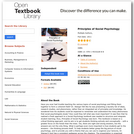
Have you ever had trouble teaching the various topics of social psychology and fitting them together to form a coherent field? Dr. Stangor felt like he was presenting a laundry list of ideas, research studies, and phenomena, rather than an integrated set of principles and knowledge. He wondered how his students could be expected to remember and understand the many phenomena that social psychologists study? How could they tell what was most important? It was then that he realized a fresh approach to a Social Psychology textbook was needed to structure and integrate student learning; thus, Principles of Social Psychology was born. This textbook is based on a critical thinking approach, and its aim is to get students thinking actively and conceptually Đ with a greater focus on the forest than the trees. Yes, there are right and wrong answers, but the answers are not the only thing. What is perhaps even more important is how students get to the answers Đ the thinking process itself. To help students better grasp the big picture of social psychology, and to provide you with a theme that you can use to organize your lectures, Dr. Stangor's text has a consistent pedagogy across the chapters.
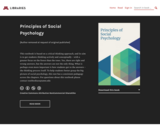
Principles of Social Psychology is adapted from a work produced by a publisher who has requested that they and the original author not receive attribution. This adapted edition is produced by the University of Minnesota Libraries Publishing through the eLearning Support Initiative. For questions about this textbook please contact textbookuse@umn.edu

Psychology can be considered as the scientific study of brains and behaviours. This is an admittedly broad definition: in this course, you will have the opportunity to learn about just some of many ways that psychological science plays a role in our lives. Thank you for being with us as we begin to lay the foundation for further exploration into this discipline.
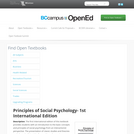
The first International edition of this textbook provides students with an introduction to the basic concepts and principles of social psychology from an interactionist perspective. The presentation of classic studies and theories are balanced with insights from cutting-edge, contemporary research. An emphasis on real world examples and applications is intended to guide students to critically analyze their situations and social interactions in order to put their knowledge to effective use.

Assessment is the gathering of information to improve decision-making. There are many approaches to psychological assessment that can be used to assess people’s thoughts, emotions, and behaviors, including self-report questionnaires, questionnaires reported by others, interviews, observations, biopsychological assessments, performance-based assessments, archival approaches, and combinations of these. However, the field has paid insufficient attention to measurement. There has been a proliferation of pseudoscience in assessment, including inaccurate assessments that can potentially cause harm. It is crucial to use assessments that are supported by science—with strong psychometric properties, including reliability and validity, and to develop better assessments.
This book discusses the principles of psychological assessment to help researchers and clinicians better develop, evaluate, administer, score, integrate, and interpret psychological assessments. It is intended for use by graduate students, faculty, researchers, and practicing psychologists. The book discusses psychometrics (reliability and validity), the assessment of various psychological domains (behavior, personality, intellectual functioning), various measurement methods (e.g., questionnaires, observations, interviews, biopsychological assessments, performance-based assessments), and emerging analytical frameworks to evaluate and improve assessment, including generalizability theory, structural equation modeling, item response theory, and signal detection theory. The book also discusses considerations of ethics, test bias, and cultural and individual diversity.
The book provides analysis examples using the free software, R, to help readers apply the principles to research and practice. The text, analysis code/syntax, R output, figures, and interpretation are all integrated to help guide readers. The book uses the freely available petersenlab package for R, which includes many functions relevant for assessment. The dissemination of these principles and tools will promote the development of more efficient and accurate assessment strategies that will lead to important scientific advancements and improved intervention.

Adaptation for UBC PSYC 308A
Short Description:
Helping students organize their thinking about social psychology at a conceptual level. UBC Psych 308A adaptations include removing the section on leadership, condensing and merging the chapters on competition and cooperation into the chapter on working groups. Numerous key vocabulary terms (along with their accompanying sections) were removed.
Long Description:
The first International edition of this textbook provides students with an introduction to the basic concepts and principles of social psychology from an interactionist perspective. The presentation of classic studies and theories are balanced with insights from cutting-edge, contemporary research. An emphasis on real world examples and applications is intended to guide students to critically analyze their situations and social interactions in order to put their knowledge to effective use.
Word Count: 233508
(Note: This resource's metadata has been created automatically by reformatting and/or combining the information that the author initially provided as part of a bulk import process.)

Short Description:
The first international edition of this textbook provides students with an introduction to the basic concepts and principles of social psychology from an interactionist perspective. The presentation of classic studies and theories are balanced with insights from cutting-edge, contemporary research. An emphasis on real world examples and applications is intended to guide students to critically analyze their situations and social interactions in order to put their knowledge to effective use. In 2022, 25 interactive H5P activities were added throughout the book.
Word Count: 274076
ISBN: 978-1-77420-193-0
(Note: This resource's metadata has been created automatically by reformatting and/or combining the information that the author initially provided as part of a bulk import process.)
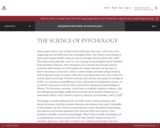
This textbook introduces students to the fundamental principles of what it is like to think like a psychology researcher in the contemporary world of psychology research.
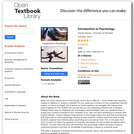
When you teach Introduction to Psychology, do you find it difficult – much harder than teaching classes in statistics or research methods? Do you easily give a lecture on the sympathetic nervous system, a lecture on Piaget, and a lecture on social cognition, but struggle with linking these topics together for the student? Do you feel like you are presenting a laundry list of research findings rather than an integrated set of principles and knowledge? Have you wondered how to ensure your course is relevant to your students? If so, then you have something in common with Charles Stangor.Charles Stangor's Introduction to Psychology utilizes the dual theme of behavior and empiricism to make psychology relevant to intro students.Charles wrote this book to help students organize their thinking about psychology at a conceptual level. Five or ten years from now, he does not expect his students to remember the details of most of what he teaches them. However, he does hope that they will remember that psychology matters because it helps us understand behavior and that our knowledge of psychology is based on empirical study.This book is designed to facilitate these learning outcomes, and he has used three techniques to help focus students on behavior:Chapter Openers: Each chapter opens showcasing an interesting real world example of people who dealing with behavioral questions and who can use psychology to help them answer them. The opener is designed to draw the student into the chapter and create an interesting in learning about the topic.Psychology in Everyday Life: Each chapter contains one or two features designed to link the principles from the chapter to real-world applications in business, environment, health, law, learning, and other relevant domains. For instance, the application in Chapter 7 on Development, “What makes good parents” applies the concepts of parenting styles in a mini-handbook about parenting, and the application in Chapter 3 is about the difficulties that left-handed people face performing everyday tasks in a right-handed world.Research Foci: Introduction to Psychology emphasizes empiricism throughout, but without making it a distraction from the main story line. Each chapter presents two close-ups on research -- well articulated and specific examples of research within the content area, each including a summary of the hypotheses, methods, results, and interpretations. This feature provides a continuous thread that reminds students of the importance of empirical research. The research foci also emphasize the fact that findings are not always predictable ahead of time (dispelling the myth of hindsight bias), and also help students understand how research really works.Charles Stangor's focus on behavior and empiricism has produced, Introduction to Psychology, a text that is better organized, has fewer chapters, and is somewhat shorter than many of the leading books.
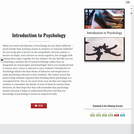
When you teach Introduction to Psychology, do you find it difficult — much harder than teaching classes in statistics or research methods? Do you easily give a lecture on the sympathetic nervous system, a lecture on Piaget, and a lecture on social cognition, but struggle with linking these topics together for the student? Do you feel like you are presenting a laundry list of research findings rather than an integrated set of principles and knowledge? Have you wondered how to ensure your course is relevant to your students? Introduction to Psychology utilizes the dual theme of behavior and empiricism to make psychology relevant to intro students. The author wrote this book to help students organize their thinking about psychology at a conceptual level. Five or ten years from now, he does not expect his students to remember the details of most of what he teaches them. However, he does hope that they will remember that psychology matters because it helps us understand behavior and that our knowledge of psychology is based on empirical study.
This is a derivative of INTRODUCTION TO PSYCHOLOGY by a publisher who has requested that they and the original author not receive attribution, which was originally released and is used under CC BY-NC-SA. This work, unless otherwise expressly stated, is licensed under a Creative Commons Attribution-NonCommercial-ShareAlike 4.0 International License.

This books lays the foundation for prospective teachers to learn about various teaching methodologies and covers material typically found in many teacher training programs. Chapters in the text can be assigned either from beginning to end, as with a conventional printed book, or they can be selected in some other sequence to meet the needs of particular students or classes. In general the first half of the book focuses on broader questions and principles taken from psychology per se, and the second half focuses on somewhat more practical issues of teaching. But the division between “theory” and “practice” is only approximate; all parts of the book draw on research, theory, and practical wisdom wherever appropriate. Chapter 2 is about learning theory, and Chapter 3 is about development; but as we point out, these topics overlap with each other as well as with the concerns of daily teaching. Chapter 4 is about several forms of student diversity (what might be called individual differences in another context), and Chapter 5 is about one form of diversity that has become prominent in schools recently—students with disabilities. Chapter 6 is about motivation, a topic that is heavily studied by psychological researchers, but that also poses perennial challenges to classroom teachers.

1st Canadian Edition
Short Description:
See also: Introduction to Psychology Student Study Guide Download FREE digital formats or read online.This book is designed to help students organize their thinking about psychology at a conceptual level. The focus on behaviour and empiricism has produced a text that is better organized, has fewer chapters, and is somewhat shorter than many of the leading books. The beginning of each section includes learning objectives; throughout the body of each section are key terms in bold followed by their definitions in italics; key takeaways, and exercises and critical thinking activities end each section.
Long Description:
This book is designed to help students organize their thinking about psychology at a conceptual level. The focus on behaviour and empiricism has produced a text that is better organized, has fewer chapters, and is somewhat shorter than many of the leading books. The beginning of each section includes learning objectives; throughout the body of each section are key terms in bold followed by their definitions in italics; key takeaways, and exercises and critical thinking activities end each section.
To facilitate learning outcomes, three techniques have been used: Chapter openers.The focus on behaviour begins each chapter with an opener showcasing an interesting real-world example of people who are dealing with behavioural questions and who can use psychology to help them answer those questions. The opener is designed to draw the student into the chapter and create an interest in learning about the topic. Psychology in everyday life.Each chapter contains one or two features designed to link the principles from the chapter to real-world applications in business, environment, health, law, learning, and other relevant domains. For instance, the application in Chapter 7 “Growing and Developing” — “What Makes a Good Parent?” — applies the concepts of parenting styles in a mini handbook about parenting, and the application in Chapter 4, “Brains, Bodies, and Behaviour,” is about the difficulties that left-handed people face performing everyday tasks in a right-handed world. Research focus.Empiricism is also emphasized throughout, but without making it a distraction from the main story line. Each chapter presents one or more close-ups on research — well-articulated and specific examples of research within the content area, each including a summary of the hypotheses, methods, results, and interpretations. This feature provides a continuous thread that reminds students of the importance of empirical research. The research foci also emphasize the fact that findings are not always predictable ahead of time (dispelling the myth of hindsight bias) and help students understand how research really works.
In short, the authors have attempted to bring psychology to life in ways that really matter to students while, at the same time, maintaining content and conceptual rigor, with a strong focus on the fundamental principles of empiricism and the scientific method.
Word Count: 283717
ISBN: 978-1-998755-20-2
(Note: This resource's metadata has been created automatically by reformatting and/or combining the information that the author initially provided as part of a bulk import process.)

Includes sample syllabus, Edited & Remixed: Tao of Positive Psychology, Possible Course Materials & Resources, and Proposed Term Schedule.
PSY 439 Positive Psychology
Examines psychological factors and principles that help explain positive outcomes, well-being and personal growth in humans. Areas of focus will include positive emotional experiences and appraisals such a happiness, life satisfaction, well-being, positive personal characteristics, interests and values, and positive institutions as they promote growth and fulfilling experiences. There will be a significant applied component of the class in which students will explore their own reactions and personal qualities.
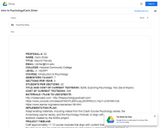
Introduction to the study and principles of behavior. Topics include general principles of scientific investigation; physiological bases of behavior including sensation, perception, learning, emotion and motivation; development; individual differences; attitudes and group dynamics.
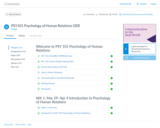
Psychology of Human Relations Canvas Course
PSY 101
COURSE DESCRIPTION
The purpose of this course is to enhance students’ understanding of the variety and complexity of human interactions. The focus is on the practical application of psychology in everyday situations; topics include self-concept, perception, personality development, cultural diversity, conflict resolution, emotions, stress, interpersonal communication, workplace success, and behavioral change.
COURSE LEARNING OUTCOMES
CLOs describe in observable and measurable terms what a student is able to do as a result of completing this class.
CLO1. Identify key concepts, principles and the multiple perspectives of psychology including:
Psychodynamic, Behavioral, Humanistic, Cognitive, Biological, Sociocultural and Evolutionary.
CLO2. Explain behavior using a biopsychosocial approach.
CLO3. Apply course content using real world examples and situations.
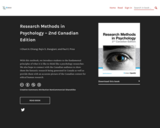
Short Description:
Note: An updated edition of this book was published October 2020. You can find it here: Research Methods in Psychology - 4th Edition. With this textbook, we introduce students to the fundamental principles of what it is like to think like a psychology researcher. We also hope to connect with the Canadian audience to show them the fantastic research being generated in Canada as well as provide them with an accurate picture of the Canadian context for ethical human research.
Long Description:
Note: The second edition of this book was published October 2020. You can find it here: Research Methods in Psychology – 4th Edition
With this textbook, we introduce students to the fundamental principles of what it is like to think like a psychology researcher. We also hope to connect with the Canadian audience to show them the fantastic research being generated in Canada as well as provide them with an accurate picture of the Canadian context for ethical human research.
Word Count: 119700
ISBN: 978-1-77420-011-7
(Note: This resource's metadata has been created automatically by reformatting and/or combining the information that the author initially provided as part of a bulk import process.)
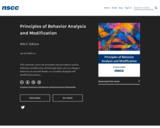
NSCC Edition
Short Description:
This textbook covers the principles and procedures used in behaviour modification and through them, you can change a behaviour in yourself thanks to a carefully designed self-modification project.
Word Count: 89676
ISBN: 978-1-998755-40-0
(Note: This resource's metadata has been created automatically by reformatting and/or combining the information that the author initially provided as part of a bulk import process.)

Short Description:
This book is designed to help students organize their thinking about psychology at a conceptual level. The focus on behaviour and empiricism has produced a text that is better organized, has fewer chapters, and is somewhat shorter than many of the leading books. The beginning of each section includes learning objectives; throughout the body of each section are key terms in bold followed by their definitions in italics; key takeaways, and exercises and critical thinking activities end each section.
Long Description:
This book is designed to help students organize their thinking about psychology at a conceptual level. The focus on behaviour and empiricism has produced a text that is better organized, has fewer chapters, and is somewhat shorter than many of the leading books. The beginning of each section includes learning objectives; throughout the body of each section are key terms in bold followed by their definitions in italics; key takeaways, and exercises and critical thinking activities end each section.
To facilitate learning outcomes, three techniques have been used: Chapter openers.The focus on behaviour begins each chapter with an opener showcasing an interesting real-world example of people who are dealing with behavioural questions and who can use psychology to help them answer those questions. The opener is designed to draw the student into the chapter and create an interest in learning about the topic. Psychology in everyday life.Each chapter contains one or two features designed to link the principles from the chapter to real-world applications in business, environment, health, law, learning, and other relevant domains. For instance, the application in Chapter 7 “Growing and Developing” — “What Makes a Good Parent?” — applies the concepts of parenting styles in a mini handbook about parenting, and the application in Chapter 4, “Brains, Bodies, and Behaviour,” is about the difficulties that left-handed people face performing everyday tasks in a right-handed world. Research focus.Empiricism is also emphasized throughout, but without making it a distraction from the main story line. Each chapter presents one or more close-ups on research — well-articulated and specific examples of research within the content area, each including a summary of the hypotheses, methods, results, and interpretations. This feature provides a continuous thread that reminds students of the importance of empirical research. The research foci also emphasize the fact that findings are not always predictable ahead of time (dispelling the myth of hindsight bias) and help students understand how research really works.
In short, the authors have attempted to bring psychology to life in ways that really matter to students while, at the same time, maintaining content and conceptual rigor, with a strong focus on the fundamental principles of empiricism and the scientific method.
Word Count: 283935
ISBN: 978-1-77420-005-6
(Note: This resource's metadata has been created automatically by reformatting and/or combining the information that the author initially provided as part of a bulk import process.)

3rd American Edition
Short Description:
This third American edition is a comprehensive textbook for research methods classes. It is an adaptation of the second American edition.
Long Description:
This textbook is an adaptation of one written by Paul C. Price (California State University, Fresno) and adapted by The Saylor Foundation under a Creative Commons Attribution-NonCommercial-ShareAlike 3.0 License without attribution as requested by the work’s original creator or licensee. The original text is available here: http://www.saylor.org/site/textbooks/
The first Canadian edition (published in 2013) was authored by Rajiv S. Jhangiani (Kwantlen Polytechnic University) and was licensed under a Creative Commons Attribution-NonCommercial-ShareAlike 3.0 License. Revisions included the addition of a table of contents, changes to Chapter 3 (Research Ethics) to include a contemporary example of an ethical breach and to reflect Canadian ethical guidelines and privacy laws, additional information regarding online data collection in Chapter 9 (Survey Research), corrections of errors in the text and formulae, spelling changes from US to Canadian conventions, the addition of a cover page, and other necessary formatting adjustments.
The second adaptation incorporated the second Canadian edition (published in 2013) by Rajiv S. Jhangiani (Kwantlen Polytechnic University) and I-Chant A. Chiang (Quest University Canada), licensed under a Creative Commons Attribution-NonCommercial-ShareAlike 4.0 International License. Major revisions included numerous new examples and links to outside resources throughout the book, references to replicability and open science (Chapters 1 and 13), and additions to discussions of validity (Chapters 5 & 6), the addition of a glossary of key terms, and numerous illustrations, descriptions, and exercises throughout.
The second American edition constituted a major revision for the first Canadian edition was the substitution of the original ethics chapter (Chapter 3) from the first American edition, and the reversion of Canadian spelling conventions to American spelling conventions.
Cover photo: “Great Wave off Kanagawa” after Katsushika Hokusai (葛飾北斎) is public domain.
The third U.S. edition was authored by Carrie Cuttler (Washington State University) in 2017 and is licensed under a Creative Commons Attribution-NonCommercial-ShareAlike 4.0 International License. Revisions in the current edition include general reorganization, language revision, spelling, formatting, additional video links, and examples throughout. More specifically, the overall model section was moved from Chapter 1 to Chapter 2, new sections were added to Chapter 1 on methods of knowing and goals of science, and a link on the replication crisis in psychology was added to Chapter 1. Chapter 2 was also reorganized by moving the section on reviewing the research literature to earlier in the chapter and taking sections from Chapter 4 (on theories and hypotheses), moving them to Chapter 2, and cutting the remainder of Chapter 4. Sections of Chapter 2 on correlation were also moved to Chapter 6. New sections on characteristics of good research questions, an overview of experimental vs. non-experimental research, a description of field vs. lab studies, and making conclusions were also added to Chapter 2. Chapter 3 was expanded by adding a definition of anonymity, elaborating on the Belmont Report (the principles of respect for persons and beneficence were added), and adding a link to a clip dispelling the myth that vaccines cause autism. Sections from Chapter 4 (on defining theories and hypotheses) were moved to Chapter 2 and the remainder of the previous Chapter 4 (on phenomenon, theories, and hypotheses) was cut. Chapter 5 was reorganized by moving the sections on four types of validity, manipulation checks, and placebo effects to later in the chapter. Descriptions of single factor two-level designs, single factor multi-level designs, matched-groups designs, order effects, and random counterbalancing were added to Chapter 5 and the concept of statistical validity was expanded upon. Chapter 6 was also reorganized by moving sections describing correlation coefficients from Chapters 2 and 12 to Chapter 6. The section of the book on complex correlation was also moved to Chapter 6 and the section on quasi-experiments was moved from Chapter 6 to its own chapter (Chapter 8). The categories of non-experimental research described in Chapter 6 were change to cross-sectional, correlational, and observational research. Chapter 6 was further expanded to describe cross-sectional studies, partial correlation, simple regression, the use of regression to make predictions, case studies, participant observation, disguised and undisguised observation, and structured observation. The terms independent variable and dependent variable as used in the context of regression were changed to predictor variable and outcome/criterion variable respectively. A distinction between proportionate stratified sampling and disproportionate stratified sampling was added to Chapter 7. The section on quasi-experimental designs was moved to its own chapter (Chapter 8) and was elaborated upon to include instrumentation and testing as threats to internal validity of one-group pretest-posttest designs, and to include sections describing the one-group posttest only design, pretest-posttest nonequivalent groups design, interrupted time-series with nonequivalent groups design, pretest-posttest design with switching replication, and switching replication with treatment removal designs. The section of Chapter 9 on factorial designs was split into two sections and the remainder of the chapter was moved or cut. Further, examples of everyday interactions were added and a description of simple effects was added to Chapter 9. The section on case studies that appeared in Chapter 10 was edited and moved to Chapter 6. Further, labels were added to multiple-baseline across behaviors, settings, and participants designs, and a concluding paragraph on converging evidence was added to Chapter 10. Only minor edits were made to the remaining chapters (Chapters 11, 12, and 13).
Year of Publication: 2017
Word Count: 119055
(Note: This resource's metadata has been created automatically by reformatting and/or combining the information that the author initially provided as part of a bulk import process.)